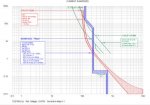PE (always learning)
Senior Member
- Location
- Saint Louis
- Occupation
- Professional Engineer
Hey everyone,
So I have a question in regards to transformer damage curves and how to optimize protection between the utility primary fuse and the main circuit breaker on the secondary side. My utility transformer is 750 kVA and my main size is 3000 amps. I know the transformer size seems oddly low for a 3000 amp main, but the utility has sized the transformer based on the demand load. My question is, what would be my optimal settings for the secondary 3000 amp main breaker in order to protect the transformer? I don't think I will be able to put any practical settings to protect the transformer from thermal overload on the secondary because the breaker is too large. In this case would my primary fuse be doing all the protection? I have attached a TCC of this scenario for your reference.
Best Regards,
Eric Fiedler
So I have a question in regards to transformer damage curves and how to optimize protection between the utility primary fuse and the main circuit breaker on the secondary side. My utility transformer is 750 kVA and my main size is 3000 amps. I know the transformer size seems oddly low for a 3000 amp main, but the utility has sized the transformer based on the demand load. My question is, what would be my optimal settings for the secondary 3000 amp main breaker in order to protect the transformer? I don't think I will be able to put any practical settings to protect the transformer from thermal overload on the secondary because the breaker is too large. In this case would my primary fuse be doing all the protection? I have attached a TCC of this scenario for your reference.
Best Regards,
Eric Fiedler


